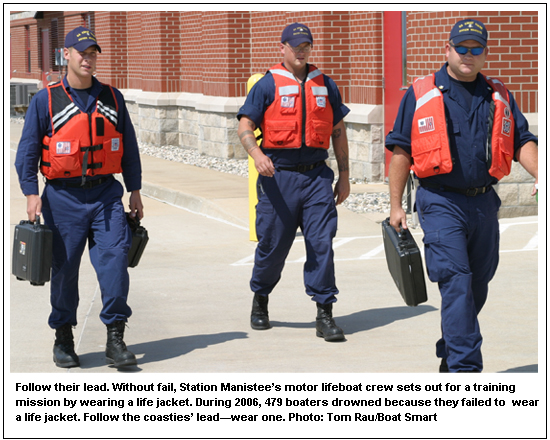| Coast
Guard Boating Report a Must Read
by Tom Rau

The Coast Guard’s
2006 annual Boating Statistics report on recreational
boating is an absolute must-read
report. This enthralling detailed account of recreational
boating reads with the precision of a CAT scan.
With insightful
details, the report presents its findings in a
statistical format that would make an accountant
smile with its ease of use and reading clarity.
By law, states are required to report to the Coast
Guard boating accidents if a person dies, or if
a person is injured and requires medical treatment,
or damage to a boat exceeds $2,000.
The Coast Guard
believes that most boating fatalities find their
way into the system but most boating accidents
go unreported. I often wonder what act of fate
spared one boater and drew another into the data
base. I believe it’s often a slight nuance
in fate that spares many boaters. It is for that
reason I write the Boat Smart column to expose
just how thin the line is between going home safely
or not going home at all. Let’s review a
summary of the latest 2006 Boating Statistics
followed with my comments.
- The number of boating deaths,
injuries and property damage increased for
the second consecutive year. In 2006 there
were 710 boating deaths compared to 697 for
2005.
Comment: For years, the fatality
count has been going down. Although I find
this recent increase disturbing, it does not
surprise me. Boaters failing towear life jackets
will continue to take its toll. Until that
trend is reversed, expect boating deaths to
continue at current levels, if not increase.
- “Overall,
two-thirds of all fatal boating accident victims
drowned. Of those who drowned, 90 percent
of the victims were not wearing a lifejacket.
Eight out of every ten boaters who drowned
were using boats less than 20 feet in length.”
Comment: With the increase
in fuel prices, I predict more boaters will
elect to operate smaller more fuel-efficient
boats. That concerns me when you consider
eight out of every ten boaters who drowned
were on boats less that 20 feet in length.
- “Consistent
with previous years, 70 percent of reported
fatalities occurred on boats where the operator
had not received boating safety instruction.
Comment: Until we have mandatory
boating education for all boaters regardless
of their age, expect boating deaths to continue
or exceed current levels. I urge those that
oppose or resist mandatory boating education
to pay heed to the high percentage of fatalities
linked to a lack of boating education. In
recent years this figure has been as high
89 percent.
- “Operator
inattention, carelessness/ reckless operation,
excessive speed, and no proper lookout are
the primary contributing factors in all reported
accidents.”
Comment: Lack of a proper
lookout and speed are the primary cause of
most boat collisions, that and alcohol. I
suspect the increase in small, fast boats
can be linked to an increase in boating fatalities
and injuries. I often hear disgruntlement
from boaters regarding the increase in fast
boats, especially on inland lakes.
- “Alcohol
use is the leading contributing factor in
fatal boating accidents; accounting for nearly
20 percent of all reported fatalities.”
Comment: In my book, Boat
Smart Chronicles, Lake Michigan Devours Its
Wounded, I make a strong case for why boating
under the influence should be linked to a
person’s motor vehicle driving record
as legislators have done in the State of Indiana.
It’s one thing to lose boating privileges,
another to lose motor vehicle driving privileges.
For certain, it will get boaters to take seriously
the consequences of operating a boat under
the influence.
- “Twenty-nine
children age 12 and under lost their lives
while boating in 2006; compared to 21 children
in 2005 and 14 children in 2004. Nearly twice
as many children drowned in 2006 compared
to 2004.”
Comment: The fatality rate amongst
children age 12 and under has more than doubled
in two years. Of the 29 children age 12 and
under that died, 15 were due to drowning,
the other 14 involved boat collisions and
other physical traumas.
-
“The most common
types of boats involved in reported accidents
were open motorboats at forty-five percent,
personal watercraft at twenty-four percent
and cabin motorboats at fourteen percent.
A significant increase was observed in the
fatalities involving canoes and kayaks,
with 99 fatalities reported in 2006 compared
78 in 2005.”
Comment: I absolutely refuse to
get underway on a small boat whether it
be power or paddle without wearing a life
jacket. These revealing boating statistics
and much more can be visited at www.boatsmart.net.
Believe me, this highly acclaimed report
is an absolute must read
Tom Rau is a long-time Coast Guard rescue
responder and syndicated boating safety columnist.
Look for his book, Boat Smart Chronicles, a shocking
expose on recreational boating — reads like
a great ship’s log spanning over two decades.
It’s available to order at: www.boatsmart.net,
www.seaworthy.com,
www.amazon.com,
or through local bookstores.
TOP
|